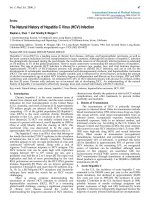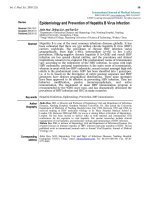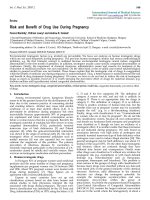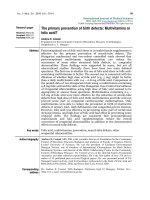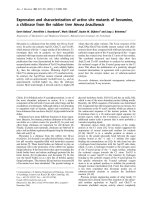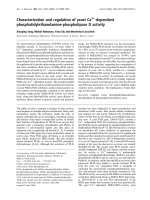Báo cáo y học: "Epidemiology and Prevention of Hepatitis B Virus Infection"
Bạn đang xem bản rút gọn của tài liệu. Xem và tải ngay bản đầy đủ của tài liệu tại đây (290.14 KB, 8 trang )
Int. J. Med. Sci. 2005 2(1)
50
International Journal of Medical Sciences
ISSN 1449-1907 www.medsci.org 2005 2(1):50-57
©2005 Ivyspring International Publisher. All rights reserved
Epidemiology and Prevention of Hepatitis B Virus Infection
Review
Received: 2004.10.01
Accepted: 2005.01.01
Published:2005.01.05
Jinlin Hou
1
, Zhihua Liu
1
, and Fan Gu
2
1
Department of Infectious Diseases and Hepatology Unit, Nanfang Hospital, Nanfang
Medical University, Guangzhou, China;
2
Tongji Medical College, Huazhong University of Science &Technology, Wuhan, China
A
A
b
b
s
s
t
t
r
r
a
a
c
c
t
t
Hepatitis B is one of the most common infectious diseases globally. It has
been estimated that there are 350 million chronic hepatitis B virus (HBV)
carriers worldwide. The prevalence of chronic HBV infection varies
geographically, from high (>8%), intermediate (2-7%) to low (<2%)
prevalence. HBeAg-negative chronic hepatitis B (e-CHB) and occult HBV
infection are two special clinical entities, and the prevalence and clinical
implications remain to be explored. The predominant routes of transmission
vary according to the endemicity of the HBV infection. In areas with high
HBV endemicity, perinatal transmission is the main route of transmission,
whereas in areas with low HBV endemicity, sexual contact amongst high-risk
adults is the predominant route. HBV has been classified into 7 genotypes,
i.e. A to G, based on the divergence of entire genome sequence and HBV
genotypes have distinct geographical distributions. Three main strategies
have been approved to be effective in preventing HBV infection. They are
behavior modification, passive immunoprophylaxis, and active
immunization. The implement of mass HBV immunization program is
recommended by the WHO since 1991, and has dramatically decreased the
prevalence of HBV infection and HCC in many countries.
K
K
e
e
y
y
w
w
o
o
r
r
d
d
s
s
Hepatitis B infection, Epidemiology, Prevention, HBV immunization
A
A
u
u
t
t
h
h
o
o
r
r
b
b
i
i
o
o
g
g
r
r
a
a
p
p
h
h
y
y
Jinlin Hou, MD, is Director and Professor of Hepatology Unit and Department of Infectious
Diseases, Nanfang Hospital, Southern Medical University. Dr. Hou joined the University
Department of Medicine of Nanfang Hospital since July 1984. Between 1993 and 1994, he
received training in HBV molecular virology in St. Mary Hospital Medical School in
London, UK. Between 2000 and 2001, he was as a visiting fellow at Institute of Hepatology,
London. He has been invited to deliver talks in both national and international liver
conferences for his expertise in viral hepatitis. His current researches include clinical
management of viral hepatitis, and molecular virology and immunology of HBV infection.
Zhihua Liu, PhD, is lecturer of Hepatology Unit and Department of Infectious Diseases. His
research focuses on immune response of HBV infection and gene mutation of HBV. He has
published work in international journals such as Journal Viral Hepatitis, Journal of Medical
Virology, etc.
C
C
o
o
r
r
r
r
e
e
s
s
p
p
o
o
n
n
d
d
i
i
n
n
g
g
a
a
d
d
d
d
r
r
e
e
s
s
s
s
Jinlin Hou, M.D, Hepatology Unit and Dept. of Infectious Diseases, Nanfang Hospital,
Guangzhou 510515, China. email:
Tel: 86-20-61641941 Fax: 86-20-
87714940
Int. J. Med. Sci. 2005 2(1)
51
1. Introduction
Hepatitis B virus (HBV) is a serious public health problem worldwide and major cause of chronic hepatitis, cirrhosis, and
hepatocellular carcinoma (HCC). It was estimated that approximately 2 billion people have serological evidence of past or present
HBV infection. More than 350 million are chronic carriers of HBV [1]. Approximately 75% of chronic carriers live in Asia and the
Western Pacific [2]. It was reported that 15-40% of HBV infected patients would develop cirrhosis, liver failure, or HCC [3], and
500, 000 to 1.2 million people die of HBV infection annually [4,5]. Because of the high HBV-related morbidity and mortality, the
global disease burden of HB is substantial.
2. Epidemiology
The prevalence of chronic HBV infection varies greatly in different part of the world (Figure 1). The prevalence of chronic
HBV infection worldwide could be categorized as high, intermediate and low endimicity. The age at the time of infection is
associated with the endemicity of HBV infection (Table 1).
High Endemicity
The prevalence of HBV infection varies markedly throughout regions of the world [6]. Hepatitis B is highly endemic in
developing regions with large population such as South East Asia, China, sub-Saharan Africa and the Amazon Basin, where at least
8% of the population are HBV chronic carrier. In these areas, 70–95% of the population shows past or present serological evidence
of HBV infection. Most infections occur during infancy or childhood. Since most infections in children are asymptomatic, there is
little evidence of acute disease related to HBV, but the rates of chronic liver disease and liver cancer in adults are high [7].
Intermediate Endemicity
Hepatitis B is moderately endemic in part of Eastern and Southern Europe, the Middle East, Japan, and part of South America.
Between 10–60% of the population have evidence of infection, and 2-7% are chronic carriers. Acute disease related to HBV is
common in these areas because many infections occur in adolescents and adults; however, the high rates of chronic infection are
maintained mostly by infections occurring in infants and children [8]. In these areas, mixed patterns of transmission exist, including
infant, early childhood and adult transmission.
Low
Endemicity
The endemicity of HBV is low in most developed areas, such as North America, Northern and Western Europe and Australia.
In these regions, HBV infects 5–7% of the population, and only 0.5–2% of the population are chronic carriers [9]. In these areas,
most HBV infections occur in adolescents and young adults in relatively well-defined high-risk groups, including injection drug
user, homosexual males, health care workers, patients who require regular blood transfusion or hemodialysis.
3. HBV Transmission
HBV is spread through contact with infected body fluids and the only natural host is human. Blood is the most important
vehicle for transmission, but other body fluids have also been implicated, including semen and saliva [10,11]. Currently, three
modes of HBV transmission have been recognized: perinatal, sexual and parenteral/percutaneous transmission. There is no reliable
evidence that airborne infections occur and feces are not a source of infection. HBV is not transmitted by contaminated food or
water, insects or other vectors.
Perinatal Transmission
Transmission of HBV from carrier mothers to their babies can occur during the perinatal period, and appears to be the most
important factor in determining the prevalence of the infection in high endemicity areas, particularly in China and Southeast Asia.
Before HBV vaccine was integrated into the routine immunization program, the proportion of babies that become HBV carriers is
about 10-30% for mothers who are HBsAg-positive but HBeAg-negative. However, the incidence of perinatal infection is even
greater, around 70-90%, when the mother is both HBsAg-positive and HBeAg-positive [12,13]. There are three possible routes of
transmission of HBV from infected mothers to infants: transplacental transmission of HBV in utero; natal transmission during
delivery; or postnatal transmission during care or through breast milk. Since transplacental transmission occurs antenatally, hepatitis
B vaccine and HBIG cannot block this route. Epidemiological studies on HBV intrauterine infection in China showed that
intrauterine infection occurs in 3.7-9.9% pregnancy women with positive HBsAg and in 9.8-17.39% with positive HBsAg/HBeAg
[14-21] and it was suggested that a mother with positive HBeAg (OR = 17. 07) and a history of threatened premature labor (OR = 5.
44) are the main risk factors for intrauterine infection. The studies on transplacental transmission of HBV suggested two possible
mechanisms (1) hemagenous route: a certain of factors, such as threaten abortion, can make the placental microvascular broken, thus
the high-titer HBV maternal blood leak into fetus’ circulation [20,22]; (2) cellular transfer: the placental tissue is infected by high-
titer of HBV in maternal blood from mother’s side to fetus’ step by step, and finally, HBV reach fetus’ circulation through the
villous capillary endothelial cells [14-18].
For neonates and children younger than 1 year who acquire HBV infection perinatally, the risk of the infection becoming
chronic is 90% [23], presumably because neonates have an immature immune system. One of the possible reasons for the high rate
of chronicity is that transplacental passage of HBeAg may induce immunological tolerance to HBV in fetus.
Sexual Transmission
Sexual transmission of hepatitis B is a major source of infection in all areas of the world, especially in the low endemic areas,
such as North America. Hepatitis B is considered to be a sexually transmitted disease (STD). For a long time, homosexual men have
been considered to be at the highest risk of infection due to sexual contact (70% of homosexual men were infected after 5 years of
sexual activity) [24]. However, heterosexual transmission accounts for an increasing proportion of HBV infections. In heterosexuals,
factors associated with increased risk of HBV infection include duration of sexual activity, number of sexual partners, history of
sexual transmitted disease, and positive serology for syphilis. Sexual partners of injection drug users, prostitutes, and clients of
prostitutes are at particularly high risk for infection [25].
Int. J. Med. Sci. 2005 2(1)
52
Parenteral/percutaneous Transmission
The parenteral transmission includes injection drug use, transfusions and dialysis, acupuncture, working in a health-care setting,
tattooing and household contact. In the United States and Western Europe, injection drug use remains a very important mode of
HBV transmission (23% of all patients) [6]. Risk of acquiring infection increases with duration of injection drug use. Although the
risk for transfusion-associate HBV infection has been greatly reduced since the screening of blood for HBV markers and the
exclusion of donors who engage in high-risk activities, the transmission is still possible when the blood donors are asymptomatic
carrier with HBsAg negative [26]. Obvious sources of infection include HBV-contaminated blood and blood products, with
contaminated surgical instruments and utensils being other possible hazards. Parenteral/percutaneous transmission can occur during
surgery, after needle-stick injuries, intravenous drug use, and following procedures such as ear piercing, tattooing, acupuncture,
circumcision and scarification. The nosocomial spread of HBV infection in the hospital, particularly in dialysis units, as well as in
dental units, has been well described [6], even when infection control practices are followed. As with other modes of transmission,
high vial titers have been related to an increased risk of transmission. People at high-risk of infection include those requiring
frequent transfusions or hemodialysis, physicians, dentists, nurses and other healthcare workers, laboratory technicians, intravenous
drug users, police, firemen, laundry workers and others who are likely to come into contact with potentially infected blood and blood
products.
The risk of chronicity is low (less than 5%) for transmission through sexual contact, intravenous drug use, acupuncture, and
transfusion [23]. Individuals at risk for these transmission modes usually acquire HBV infection during adolescence or adulthood
without immune tolerance. Instead, the disease progresses directly to the immune clearance phase and is of short duration, which
probably accounts for high spontaneous recovery.
4. HBV Genotype and Its Clinical Significance
Based on an intergroup divergence of 8% or more of the complete genomes, HBV can be classified in to 7 genotypes, i.e. A-G
[27-30]. Genotype H was recently identified in central America [31]. It is well known that
HBV
genotypes have distinct
geographical
distributions. The geographical
distributions of HBV genotypes are summarized in Table 2. The prevalent HBV strains
in China are genotype B and C [32], but the two genotypes distribute unevenly in China. We studied 1096 Chinese chronic HBV
carriers from 9 provinces in Mainland China. Four major genotypes A, B, C and D were found and their prevalence were 1.2%,
41%, 52.5% and 4.3%, respectively. In northern China, genotype C is predominant (85.1%), while in southern China, genotype B is
predominant (55.0%) [Hou, et al., unpublished data]. Genotypes A and D are also found in other areas of China. However, the
genotypes E-H have not been reported in China. Recently, genotype C/D hybrid was identified in Tibet [33] and genotype B was
found recombinated with preC/C region of genotype C in China [34]. Accumulated data suggest the importance of genotype,
subgroup and recombination that may influence the biological characteristics of virus and clinical outcome of HBV infection.
Several studies reported a correlation of HBV genotypes with HBeAg clearance, liver damage, and the response to IFN treatment. It
was reported that HBeAg carrier status tends to be longer and the prevalence of HBeAg appears higher in patients with genotype C
than with genotype B [35,36]. HBV carriers with genotype B have lower histologic activity scores [37], and genotype C is more
prevalence in patients with cirrhosis [38,39]. Furthermore, a retrospective study showed that HBV genotype B is associated with a
higher rate of IFN-induced HBeAg clearance compared with genotype C [40]. However, whether patients with genotype B differ
from those with genotype C in development of hepatocellular carcinoma remains controversial. The response of different HBV
genotypes to interferon-alfa treatment is of increasing interest because the benefit of interferon-alfa or its pegylated form in
combination with other antiviral agents is being explored in the treatment of chronic hepatitis B. In a homogeneous group of
prospectively followed patients from Europe, a recent study demonstrates that genotype A responds better than other HBV
genotypes to standard interferon therapy and represents an independent predictor of a therapeutic success, with a greater impact than
other pre-treatment characteristics, such as HBV DNA or ALT levels [41].
5. Occult Hepatitis B
Occult hepatitis B is defined by the presence of HBV DNA in serum or liver in the absence of HBsAg [42,43]. Serum HBV
level is usually less than 10
4
copies/ml. Although occult HBV infection has been identified in patients with chronic liver disease two
decades ago [44], its precise prevalence remains to be defined. Occult HBV infection has been found in patients with HCC, past
HBV infection, or chronic hepatitis C, and individuals without HBV serological markers. The frequency of the diagnosis depends on
the relative sensitivity of HBV DNA assays and the prevalence of HBV infection in the population. Collectively, around 30% to
35% of HBsAg-negative subjects with chronic hepatitis with or without HCC have positive serum HBV DNA (range from 5% to
55%). The prevalence of HBV DNA is higher in anti-HBc-positive, but anti-HBs-negative patients, ranging from 7% to 60% in
populations highly exposed to HBV [45]. HBV DNA is much less frequently identified in HBsAg-negative patients with acute, and
particularly fulminant hepatitis at around 10% and 7% in serum and liver samples [45]. Viral DNA persistence is not, however,
restricted to patients with liver disease and may be observed in subjects with normal liver parameters, including blood and/or organ
donors. Overall, occult HBV infection is seen in 7%-13% of anti-HBc-positive and/or anti-HBs-positive subjects, and in 0% to 17%
of blood donors.
The clinical significance of occult HBV infection remains unclear. Occult HBV infection represents a potential transmission
source of HBV via blood transfusion or organ transplantation. In addition, occult HBV infection has been associated with
cryptogenic chronic hepatitis and hepatocellular carcinoma. Furthermore, some studies suggested that occult hepatitis B might affect
responsiveness of chronic hepatitis C to interferon therapy and disease progress.
6. HBeAg-negative CHB
HBeAg-negative chronic hepatitis B (e-CHB), characterized by HBV DNA levels detectable by nonamplified assays and
continued necroinflammation in the liver, has been reported worldwide, but is more common in Mediterranean countries and Asia.
The prevalence of e-CHB is 33% in the Mediterranean, 15% in Asia Pacific, and 14% in the United States and Northern Europe
[46]. Although the presence of e-CHB is more common in the Mediterranean, its clinical impact appears greatest in China where a
Int. J. Med. Sci. 2005 2(1)
53
prevalence of 15% among HBsAg carriers equals to approximately 15 million cases of e-CHB. It is expected that the prevalence of
e-CHB tends to increase. This is supported by data from a few studies in South-east Asia. Of the 743 successive patients with CHB
in our Liver Unit, 267 (35.9%) were HBeAg-negative [47]. A cross-sectional study performed in Hong Kong showed that e-CHB
might be present in up to 17% of HBeAg-negative patients [48]. Another study conducted in Korea found that among the 413
consecutive HBeAg-negative patients, 17.7% of HBeAg-negative patients had e-CHB [49].
Most patients with e-CHB harbor HBV variants in the precore or core promoter region. The most common precore mutation,
G
1896
A, creates a premature stop codon in the precore region thus abolishing production of HBeAg [50]. The variant is commonly
found in association with HBV genotype D, which is prevalence in the Mediterranean area and is rarely detected in the United States
and North-West Europe [51,52]. The most common core promoter mutations, A
1762
T+G
1764
A, decrease transcription of precore
messenger RNA and production of HBeAg [53]. There are also clinical differences between HBeAg-positive and HBeAg-negative
chronic hepatitis B [54]. Patients with e-CHB tends to have lower serum HBV DNA levels and are more likely to have a fluctuating
course characterized by persistently elevated or fluctuating ALT levels [54,55]. Although there has been a great deal of interest in
these HBV variants, the clinical significance of these mutant viruses, particularly those described in association with severe liver
disease, remains controversial.
7. HBV and Hepatocellular Carcinoma
Epidemiologic studies have demonstrated that there is a consistent and specific
causal association between HBV infection and
HCC [56-58]. In patients with persistent HBV infection, the risk of HCC was 100 times higher than in non-infected individuals [56].
The global distribution of hepatocellular carcinoma correlates
with the geographic prevalence of chronic carriers of HBV, who
number 400 million worldwide. The highest rates are in Southeast
Asia and sub-Saharan Africa, with the HCC incidence >50/100,
000 population [59].
Virological factors in the pathogenesis of hepatocellular carcinoma
have recently been defined. Both retrospective and
prospective studies strongly supported the relation between positive HBeAg and the risk of HCC [60-62]. A prospective study in
Taiwan [62] showed that relative risk of HCC among men who were
positive for both HBsAg and HBeAg (RR=60.2) were much
higher than that among men who were
positive for HBsAg alone (RR=9.6). HBV DNA was identified as the most important
predictor of the development
of hepatocellular carcinoma in HBsAg-positive patients with different clinical conditions [63-65].
Therefore, efforts at eradicating or reducing the viral load may reduce the risk for HCC. Additionally, HBV genotype might play a
role in the development of HCC. The data from Taiwan showed that genotype C is associated with more severe liver disease
including cirrhosis and hepatocellular carcinoma (HCC), whereas genotype B is associated with the development of HCC in young
noncirrhotic patients.
8. Prevention of HBV Infection
Three main strategies are available for the prevention of HBV infection: (1) behavior modification to prevent disease
transmission, (2) passive immunoprophylaxis, and (3) active immunization.
Behavior Modification
Changes in sexual practice and improved screening measures of blood products have reduced the risk of transfusion-associated
hepatitis. Behavior modification is thought be more beneficial in developed countries than in developing countries, where neonates
and children in early childhood are at the greatest risk of acquiring infection. In these group, immunoprophylaxis, both passive and
active, will be more effective.
Passive Immunoprophylaxis
Hepatitis B Immune Globulin (HBIG) is a sterile solution of ready-made antibodies against hepatitis B. HBIG is prepared from
human blood from selected donors who already have a high level of antibodies to hepatitis B and used in passive
immunoprophylaxis. Passive immunoprophylaxis is used in four situations (1) newborns of mothers infected with hepatitis B; (2)
after needlestick exposure, (3) after sexual exposure, and (4) after liver transplantation. Immunoprophylaxis is recommended for all
infants born to HBsAg positive mothers. Current dosing recommendations are 0.13ml/kg HBIG immediately after delivery or within
12 hours after birth in combination with recombinant vaccine. The combination results in a higher-than-90% level of protection
against perinatal acquisition of HBV [66]. Between 3.7% to 9.9% of infants still acquire HBV infection perinatally from HBV-
infection mothers, despite immunoprophylaxis [14-21]. Failure of passive and active immunoprophyxis in this setting may be the
result of in utero transmission of HBV infection, perinatal transmission related to a high inoculum, and/or the presence of surface
gene escape mutants. To study the interruptive effect of HBIG before delivery in attempt to prevent intrauterine transmission of
HBV, a large-scale, random-control study was conducted in China [67]. In this study, nine hundred and eighty HBsAg carrier
pregnant women were randomly divided into HBIG group and control group. Each subject in the HBIG group received 200 IU or
400 IU of HBIG intramuscularly at 3, 2 and 1 month before delivery, in addition to newborns receiving HBIG intramuscularly. By
this way, the rate of intrauterine transmission in this group fall to 5.7%, compared to 14.3% in control group. (P < 0.001). However,
the preventive effect of HBIG administration before delivery needs to be confirmed by more study in the future.
Hepatitis B immune globulin remains a central component of prophylaxis in HBV-infected patients undergoing liver
transplantation. HBIG monotherapy given at a high dosage can prevent recurrence in 65% to 80% of patients. Because the cost of
long-term prophylaxis with high-dose HBIG is extremely high and combination therapy using HBIG with a nucleoside analog is
more uniformly effective, the current protocol is combination HBIG with a nucleoside analog after liver transplantation. These
combination protocols have reduced the rate of virologic breakthrough to 10% or less [68].
Active Immunization
Prevention of primary infection by vaccination is an important strategy to decrease the risk of chronic HBV infection and its
subsequent complications. The first-generation hepatitis B vaccine, an inactive plasma-derived vaccine, became available in 1982.
Consequently, the second generation of HB vaccine, a DNA recombinant HB vaccine was also available for general use in 1986.
Both of the vaccines were proven to be safe and efficacious in preventing HBV infection. In 1991, the World Health Organization
Int. J. Med. Sci. 2005 2(1)
54
(WHO) recommended that hepatitis B vaccination should be included in national immunization system in all countries with a
hepatitis B carrier prevalence (HBsAg) of 8% or greater by 1995 and in all countries by 1997. By May 2002, 154 countries had
routine infant immunization with hepatitis B vaccine [69].
The world’s first universal vaccination program for HBV infection was launched in 1984 in Taiwan [70-73]. During the first 2
years of the program, coverage was provided mainly for infants whose mothers were carriers of HBsAg. Vaccination was
subsequently extended, first to all newborns and then to unvaccinated preschool-age and elementary school-age children. Since
1991, catch-up vaccinations have been given to children in the first grade. This program reduced the overall HBsAg prevalence rate
from 9.8% in 1984 to 1.3% in 1994 among children <15 years of age. The HBV carrier population was further reduced through
improved maternal screening [71]. In 1999, vaccination rates were 80–86% for young children and higher than 90% for older
children; the prevalence of HBsAg was reduced to 0.7% for children younger than 15 years of age [70]. To evaluate the long-term
efficacy of hepatitis B (HB) vaccination in newborns, one of the longest HB vaccine follow-up studies in the world was conducted in
Shanghai, China [74]. Children who were born in 1986 and immunized with hepatitis B vaccine at birth were followed up at least
once a year. Serum HBsAg, anti-HBc and anti-HBs were tested. The positive rates of HBsAg in the vaccine group with the period of
16 years were 0.46%-0.97%, the average being 0.61%, which was much lower than those of baseline before vaccination and external
control. The long-term efficacy of newborn vaccination was 85.42%. In countries such as Italy and the United States, the incidence
of acute hepatitis B has declined dramatically during the past decade after vaccination program for HBV infection, particularly
among persons in younger age group [75,76].
Universal HB vaccination was proven to be effective in the prevention of HCC in several large cohort studies in Southeast
Asia. Chang et al [77] reported that the average annual incidence of HCC
in children 6 to 14 years of age declined from 0.70 per
100,000
children between 1981 and 1986 to 0.57 between 1986 and 1990,
and to 0.36 between 1990 and 1994 (P<0.01) in the first
vaccinated cohort in Taiwan. The corresponding
rates of mortality from hepatocellular carcinoma also decreased.
After universal
vaccination against HB in 1987 in Long’an, Guang Xi, a highly endemic area in Southern China, a birth cohort study was used to
evaluate the efficacy of hepatitis B vaccination. The incidence of HCC dropped from 3.27/10,000 to 0.17/10,000, a 94.8% decrease,
in the group of 0-19 year-olds. The average incidence of HCC in general population for the period from 1996 to 2002 dropped to
27.86/100, 000 from 48.18 for the period from 1969 to 1988 [78]. The protective effect of HBV vaccination against liver cancer in
adults was investigated in a cohort study in Korea. This study suggested that the immunization with HB vaccine, even in adulthood,
could reduce the risk of liver cancer [79]. The decrease in the rate of HCC after universal vaccination against hepatitis B provides
further evidence that HBV
is a cause of HCC.
Considering anti-HBs may disappear in a substantial proportion of vaccinee after initially successful vaccination, a booster dose
of vaccine, following the administration of the primary course, is recommended by most national bodies. However, is it necessary to
boost after initially successful vaccination? The results of long-term follow-up studies, together with assessment of the role of
immunological memory among vaccinees, now question the necessity of providing booster doses following a successful course of
primary immunization. In China, a long-term follow up study on HB vaccine immune efficacy showed that within the period of 16
years, the positive rate for HBsAg of the children born in 1986 ranged between 0.46 %~0.97 % with the average being 0.61 %,
which was much lower than those of the background group before vaccination, despite the rate of HBsAg positive and the geometric
mean titer declined [74]. It was suggested that the newborns who had been vaccinated completely by HBV vaccine at their birth are
unnecessary to take the booster again within 16 years. The studies in other countries also show that protection is still maintained
among vaccinees, even in HBV endemic countries, despite waning or undetectable anti-HBs levels [80-82]. Long-term B-cell
memory has been confirmed by demonstrating either the presence of anamnestic anti-HBs responses, or the presence of circulating
B cells to produce anti-HBs by a spot-enzyme-linked immunosorbent assay (ELISA) [83]. The accumulated data indicate that
protection is dependent on immune memory, rather than declining anti-HBs responses. European Consensus Group on hepatitis B
immunity recommend that following a complete course of vaccination, booster doses are unnecessary in immunocompetent persons
[84].
The effectiveness of routine infant hepatitis B immunization in significantly reducing or eliminating the prevalence of chronic
HBV infection has been demonstrated in a variety of countries and settings. However, there are still many challenges to achieve the
goal of universal childhood immunization against hepatitis B, such as poor immunization delivery infrastructure, low coverage and
lack of financial sustainability. Therefore, to continue to promote access to hepatitis B vaccines worldwide, great efforts are needed
to support countries to ensure sustained funding for immunization programs.
9. Research Direction
On epidemiology of HBV, additional research using population based samples of adequate size on a consensus definition of e-
CHB and using standard HBV DNA assays is needed to estimate the true prevalence of e-CHB and its associated HBV variants and
the precise prevalence of occult HBV infection remains to be defined. The conventional three-dose HBV vaccine schedule is not
optimal in terms of ease of implementation, record keeping, and compliance. A more immunogenic HBV vaccine that could be used
in a single dose or abbreviated schedule would be a major advance and might prove useful in reducing nonresponsiveness in
immunosuppressed individuals. Additionally, because the current vaccine must be given by injection, the development of an
effective and safe oral HBV vaccine would be advantageous.
Acknowledgement
This work was supported by a grant for the Major State Basic Research (973) Program of the People’s Republic of China
(No.G1999054106), the National Natural Science Foundation of China and the National Science Fund for Distinguished Young
Scholars.
Conflict of interest
Dr. Hou has received clinical research support from Roche, Bristol-Myers Squibb, Novartis, and GlaxoSmithKline. Others:
none declared.
